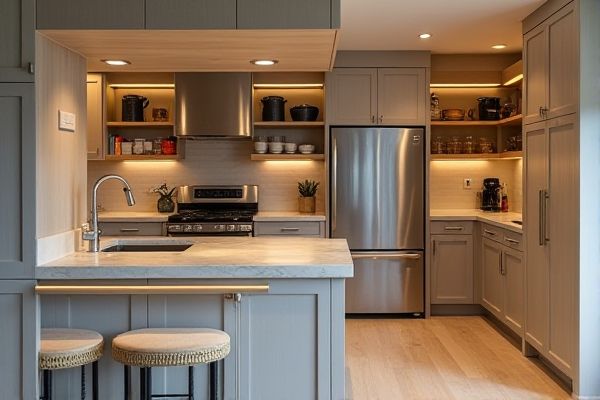
An integrated appliance pantry combines storage space with built-in kitchen appliances, maximizing functionality and streamlining your cooking area, while a storage-only pantry focuses solely on organizing food and kitchen essentials efficiently. Discover how choosing the right pantry setup can transform your kitchen workflow and enhance your culinary experience by reading the rest of the article.
Table of Comparison
| Feature | Integrated Appliance Pantry | Storage-Only Pantry |
|---|---|---|
| Purpose | Storage plus built-in appliances (e.g., ovens, microwaves) | Exclusive food and item storage |
| Space Utilization | Maximizes space by combining storage and appliance zones | Dedicated shelving; optimized for bulk storage |
| Convenience | Streamlines kitchen workflow by centralizing appliances and food access | Focus on organized storage without appliance integration |
| Cost | Higher initial investment due to appliance installation | Lower cost focused on shelving materials |
| Maintenance | Requires appliance servicing and cleaning | Low maintenance; mainly shelf upkeep |
| Design Complexity | Needs specialized design for appliance fit and ventilation | Simple design focused on storage efficiency |
Introduction to Modern Pantry Solutions
Modern pantry solutions distinguish themselves by combining storage and functionality, with integrated appliance pantries designed to house kitchen gadgets seamlessly alongside food items. Storage-only pantries prioritize maximizing shelf space and organizational capacity without accommodating appliances, ideal for small kitchens or those emphasizing bulk storage. Your choice depends on kitchen layout, appliance needs, and how you balance convenience with storage efficiency.
Definition: Integrated Appliance Pantry
An integrated appliance pantry combines traditional storage space with built-in appliances such as ovens, microwaves, or refrigerators, creating a streamlined kitchen environment. This type of pantry optimizes functionality by incorporating electrical units directly into cabinetry, improving space efficiency and accessibility. Unlike a storage-only pantry, which solely offers shelves or cabinets for food and kitchen tools, an integrated appliance pantry supports cooking and refrigeration needs within one consolidated area.
Definition: Storage-Only Pantry
A storage-only pantry is a dedicated space designed primarily for organizing and storing food items, kitchen supplies, and non-perishable goods without housing any built-in appliances. Unlike integrated appliance pantries, which incorporate ovens, microwaves, or refrigerators, storage-only pantries optimize shelving and cabinetry for maximum storage capacity and easy access. This type of pantry enhances kitchen efficiency by keeping essentials neatly arranged and separate from cooking and food preparation zones.
Design and Aesthetics Comparison
Integrated appliance pantries blend sleek cabinetry with built-in appliances, creating a seamless and modern kitchen design that maximizes space efficiency and maintains a cohesive aesthetic. Storage-only pantries emphasize extensive shelving and organizational systems, offering customizable compartments for food items without disrupting the kitchen's visual flow. The choice depends on balancing the need for appliance integration with the desire for optimized storage capacity and uncluttered design.
Space Efficiency and Layout Considerations
Integrated appliance pantries maximize space efficiency by combining storage with built-in appliances like ovens or microwaves, freeing up countertop and cabinet areas. Storage-only pantries prioritize shelving and organizational features, offering more capacity for bulk items but requiring separate spaces for appliances. Your kitchen layout benefits from choosing an integrated pantry in smaller spaces, while storage-only pantries suit larger kitchens needing extensive storage.
Functionality and Convenience
An integrated appliance pantry offers enhanced functionality by combining storage with built-in appliances such as microwaves or coffee makers, streamlining kitchen tasks and saving countertop space. Storage-only pantries prioritize maximizing shelf space for food and supplies but lack the convenience of housing appliances, which may require additional space elsewhere. Your choice depends on whether you value multi-functional design or purely optimized storage capacity for ease of access and kitchen efficiency.
Cost and Installation Factors
Integrated appliance pantries typically incur higher costs due to the need for custom cabinetry, specialized fittings, and electrical or plumbing work required for appliances like ovens or refrigerators. Installation times are longer and more complex, often involving professional contractors and precise measurements to accommodate built-in appliances seamlessly. Storage-only pantries offer a more budget-friendly and quicker installation alternative, focusing solely on shelving and organizational features without the added expense or intricacy of appliance integration.
Maintenance and Upkeep Differences
Integrated appliance pantries require regular maintenance of built-in appliances such as refrigerators, ovens, or microwaves, including cleaning filters, checking electrical components, and ensuring proper ventilation to prevent overheating. Storage-only pantries focus primarily on organizing shelves and containers, with upkeep involving routine cleaning to avoid pests and maintaining humidity levels to protect food quality. The complexity and cost of upkeep are higher for integrated appliance pantries due to the technical aspects of appliance care compared to the simpler maintenance of storage-only pantries.
Suitability for Different Lifestyles
Integrated appliance pantries suit busy households by combining storage with built-in appliances like ovens or microwaves, maximizing kitchen efficiency and accessibility. Storage-only pantries benefit minimalists or those with simple cooking habits, offering ample space for dry goods without appliance integration. Choosing between them depends on lifestyle needs, kitchen size, and frequency of cooking activities.
Conclusion: Choosing the Right Pantry for Your Home
An integrated appliance pantry combines storage space with built-in kitchen appliances, optimizing functionality and saving countertop space, while a storage-only pantry offers extensive shelving tailored for organized bulk storage and easy access. Your choice depends on kitchen size, cooking habits, and whether you prioritize appliance integration or maximum storage capacity. Selecting the right pantry enhances kitchen efficiency and complements your home's design, ensuring your space meets daily culinary needs.
 homyna.com
homyna.com